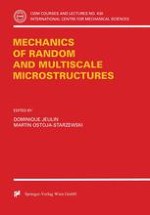2001 | OriginalPaper | Buchkapitel
The Randomness of Fatigue and Fracture Behaviour in Metallic Materials and Mechanical Structures
verfasst von : A. Pineau
Erschienen in: Mechanics of Random and Multiscale Microstructures
Verlag: Springer Vienna
Enthalten in: Professional Book Archive
Aktivieren Sie unsere intelligente Suche, um passende Fachinhalte oder Patente zu finden.
Wählen Sie Textabschnitte aus um mit Künstlicher Intelligenz passenden Patente zu finden. powered by
Markieren Sie Textabschnitte, um KI-gestützt weitere passende Inhalte zu finden. powered by
This chapter is divided into three main parts. In the first part, an attempt is made to show how, in practice, various sources of randomness are taken into account in structural integrity analysis. The emphasis is laid upon the aspects related to the microstructural details of the materials, using various examples, including brittle cleavage fracture and ductile rupture in steels. This part deals also with statistical aspects related to fatigue loading. Probabilistic linear fracture mechanics is briefly introduced. The second part is devoted to statistical modelling of fatigue damage. Both high strain low cycle fatigue (LCF) and high cycle fatigue (HCF) are considered. In LCF the emphasis is laid on kinetic theories describing the evolution of multiple cracks population while in HCF results obtained in the frame of weakest link theory are presented. A short account of directionality aspects in multiaxial fatigue damage is given. The relative importance of volume and surface effects is also discussed. In this part, a number of examples dealing with various materials, including steels, nodular cast iron and Ni base superalloys, are given. The third part is devoted to statistical aspects in ductile fracture which is a research field much less investigated in the literature compared to fatigue damage and brittle fracture. This part strongly relies upon recent studies on C-Mn steels and duplex stainless steels. It is shown that these materials exhibit a large scatter in strain to failure and a significant size effect when specimens of different sizes are tested. Microstructural investigations using quantitative image analysis have shown that ductile damage in these materials is highly heterogeneous. In order to predict rupture, finite element models are used. The materials are described using Gurson and Rousselier plastic potentials for damaging porous materials. In order to model size effects and scatter, it is necessary to account for the distribution of damage nucleation rates (duplex stainless steels) and for the spatial inhomogeneous distribution of nucleation sites (C-Mn steels) which were experimentally measured. Comparison of experiments with simulations shows that the models are able to describe both crack initiation and propagation. In particular, they can predict mean value and scatter observed on strain to failure (tensile bars) and on initiation and propagation energies (fracture mechanics specimens).
